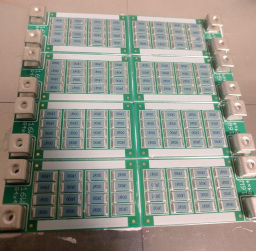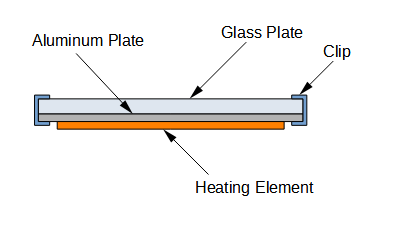FDM (Fused Deposition Modeling) 3D printers build up stacks of softened plastics by heating. By heating the bed, which is the base of the modeling process, the warping of the object is mitigated, making it easier to fix the object on the bed. This is called a heated bed.
In this article, I made my own heat bed for my self-made 3D printer.
As the heating element of the heated bed, I used Akizuki Denshi's "Precision Grade High Power Resistor Module 16 W 1 Ω" (Order Code: R-08157). This is an aluminum substrate with a number of chip resistors mounted on it.
Two sets of four modules in series are used in parallel. That means a total of eight.
Assuming the power supply voltage to be 12 V, the total power consumption is $$ 2 \times \frac{12^2}{4} = 72 [{\rm W}] $$ That is, 9 W per module.

The structure of this heated bed is composed of three layers: heat-resistant glass, aluminum plate, and heating element (resistance module).

The glass plate is "AS ONE New Glass Ceramic Protection Plate 150 Square". With a maximum continuous safe operating temperature of 700°C, it is sufficient.

The aluminum plates are 2 mm thick and 150 x 200 mm.
The aluminum plate and the heating element are bonded together with "Sunhayato SCV22 1 Liquid Room Temperature Hardening Silicone for Heat Dissipation".

The glass plate is not glued to the aluminum plate for easy maintenance, but is fixed to the aluminum plate with "double clips (25 mm wide) for office use".

I applied 12 V to the heated bed and measured the temperature of the glass surface with a radiation thermometer (Fluke 59 MAX) and it was about 100 °C.

I can adjust the temperature by changing the power supply voltage.